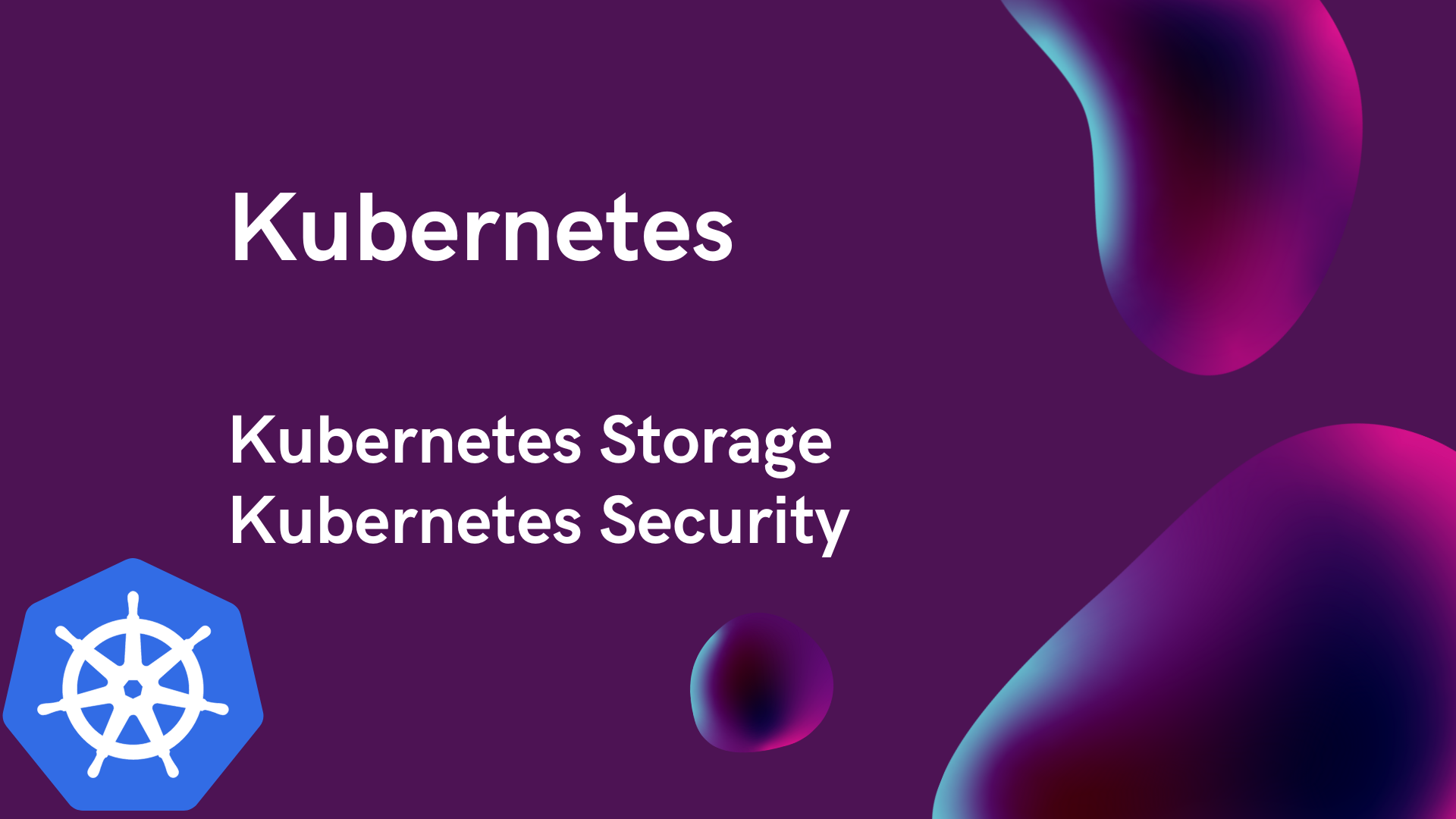Kubernetes Storage & Kubernetes Security
 praveen v
praveen vTable of contents

Kubernetes is a popular open-source container orchestration platform that automates the deployment, scaling, and management of containerized applications. One critical aspect of running containerized applications is storage. In Kubernetes, storage is managed through a series of abstractions that allow developers to define the type of storage their application needs without worrying about the underlying infrastructure.
Here are some of the main storage abstractions in Kubernetes:
Volumes: A volume is an abstraction that allows you to store data in a way that is decoupled from the container's lifecycle. A volume can be backed by various storage systems such as local disk, network storage, or cloud storage.
Persistent Volumes (PVs): A Persistent Volume is a piece of storage that is provisioned by an administrator and is available for use by the cluster. PVs can be backed by different storage systems like local disk, network storage, or cloud storage.
Persistent Volume Claims (PVCs): A Persistent Volume Claim is a request for storage by a user. When a user creates a PVC, Kubernetes finds an available PV and binds the PVC to the PV.
Storage Classes: A Storage Class is a way for administrators to define different types of storage that are available for use in the cluster. Each Storage Class is associated with a particular type of storage, and it specifies the provisioner to use for that type of storage.
In summary, Kubernetes provides various storage abstractions that allow developers to define the type of storage their application needs without worrying about the underlying infrastructure. These abstractions make it easy to manage storage in a containerized environment, and they allow applications to scale seamlessly as the storage needs grow.
Kubernetes Storage with example
Sure! Let's walk through an example of how storage can be provisioned and used in a Kubernetes environment.
Let's say we have a web application that requires persistent storage to store user data. We want to use a cloud-based storage solution, so we decide to use Amazon Elastic Block Store (EBS) as our storage backend.
First, we need to create a Persistent Volume (PV) that will represent the EBS volume we want to use. We can create a PV in Kubernetes by defining a YAML file like this:
yamlCopy codeapiVersion: v1
kind: PersistentVolume
metadata:
name: my-ebs-pv
spec:
capacity:
storage: 10Gi
accessModes:
- ReadWriteOnce
awsElasticBlockStore:
volumeID: <EBS_VOLUME_ID>
fsType: ext4
In this YAML file, we are defining a PV called my-ebs-pv that has a capacity of 10Gi and can be accessed in ReadWriteOnce mode. We are also specifying that this PV should be backed by an EBS volume with the ID <EBS_VOLUME_ID>, and that the filesystem type should be ext4.
Next, we need to create a Persistent Volume Claim (PVC) that will represent the storage request from our web application. We can create a PVC in Kubernetes by defining a YAML file like this:
yamlCopy codeapiVersion: v1
kind: PersistentVolumeClaim
metadata:
name: my-ebs-pvc
spec:
accessModes:
- ReadWriteOnce
resources:
requests:
storage: 10Gi
In this YAML file, we are defining a PVC called my-ebs-pvc that requests 10Gi of storage and can be accessed in ReadWriteOnce mode.
Finally, we can use the PVC in our web application's deployment by adding a volumes section to the deployment YAML file, like this:
yamlCopy codeapiVersion: apps/v1
kind: Deployment
metadata:
name: my-web-app
spec:
replicas: 1
selector:
matchLabels:
app: my-web-app
template:
metadata:
labels:
app: my-web-app
spec:
containers:
- name: my-web-app
image: my-web-app-image
volumeMounts:
- name: my-storage
mountPath: /data
volumes:
- name: my-storage
persistentVolumeClaim:
claimName: my-ebs-pvc
In this YAML file, we are defining a deployment called my-web-app that uses the PVC my-ebs-pvc as a volume mount at the path /data. This means that any data written to /data in the container will be stored in the EBS volume associated with the PVC.
That's a basic example of how storage can be provisioned and used in a Kubernetes environment using Amazon EBS as the backend storage solution. Of course, there are many other storage solutions and configurations that can be used, but this should give you a good idea of the overall process.
Kubernetes Security
Kubernetes is a powerful platform for container orchestration, but it's important to ensure that it is deployed securely to prevent unauthorized access or data breaches. Here are some security best practices for Kubernetes, along with an example of how they might be applied.
Secure Access to the Kubernetes API Server: Restricting access to the Kubernetes API server is essential to ensuring the security of your cluster. For example, you can enable SSL/TLS encryption for all communications to the API server and use RBAC to control who can access the API server and what they can do.
Use Network Segmentation: By segmenting your network, you can help protect your Kubernetes cluster from external threats. For example, you can place your cluster in a private subnet and use a VPN to allow authorized access.
Use Role-Based Access Control (RBAC): RBAC allows you to control who has access to your Kubernetes resources and what actions they can perform. By creating roles and assigning them to users or groups, you can ensure that only authorized personnel can make changes to your cluster.
Use Secure Image Registries: When using container images in your cluster, it's important to use secure image registries. For example, you can use a private registry that is only accessible to authorized personnel.
Monitor Kubernetes Logs: Monitoring Kubernetes logs can help you identify and respond to security threats. By analyzing logs, you can identify abnormal behavior and take action to mitigate potential risks.
Let's take an example of how we can apply these security best practices to a Kubernetes cluster. Let's say we have a Kubernetes cluster that is used to host a microservices-based application. Here are some steps we might take to secure the cluster:
Enable SSL/TLS encryption for all communications to the Kubernetes API server, and use RBAC to control access to the API server. For example, we might use a tool like cert-manager to manage SSL/TLS certificates and create RBAC roles that limit access to the API server to authorized personnel.
Segment our network by placing our cluster in a private subnet and using a VPN to allow authorized access. For example, we might use AWS VPC to create a private subnet and use a VPN gateway to allow authorized access.
Use RBAC to control access to Kubernetes resources. For example, we might create RBAC roles that limit access to our microservices and their associated resources to authorized personnel.
Use a private image registry that is only accessible to authorized personnel. For example, we might use Docker Trusted Registry or AWS Elastic Container Registry to store our container images.
Monitor Kubernetes logs using a tool like Elasticsearch, Fluentd, and Kibana (EFK) stack. By analyzing logs, we can identify abnormal behavior and take action to mitigate potential risks. For example, we might set up alerts for unusual login attempts or changes to critical resources.
By following these security best practices and taking steps to secure our Kubernetes cluster, we can help ensure the safety and integrity of our microservices-based application.
Here's an example of how Kubernetes security best practices were applied in a real-world scenario:
In September 2020, Shopify, a leading e-commerce platform, disclosed a security incident related to a misconfiguration of Kubernetes clusters. Attackers were able to access the Kubernetes control plane by exploiting a misconfigured role-based access control (RBAC) policy.
Shopify responded to the incident by taking several actions to enhance the security of its Kubernetes clusters, including:
Enabling multi-factor authentication (MFA) for all access to the Kubernetes control plane.
Implementing strict role-based access control (RBAC) policies to ensure that only authorized personnel had access to Kubernetes resources.
Limiting access to the Kubernetes API server to a small set of trusted IP addresses.
Regularly reviewing audit logs to identify any unusual behavior or potential security threats.
Conducting a comprehensive review of all Kubernetes clusters to identify any potential security vulnerabilities.
By taking these actions, Shopify was able to enhance the security of its Kubernetes clusters and prevent similar incidents from occurring in the future. This example highlights the importance of implementing security best practices in Kubernetes to prevent unauthorized access and protect sensitive data.
Subscribe to my newsletter
Read articles from praveen v directly inside your inbox. Subscribe to the newsletter, and don't miss out.
Written by
